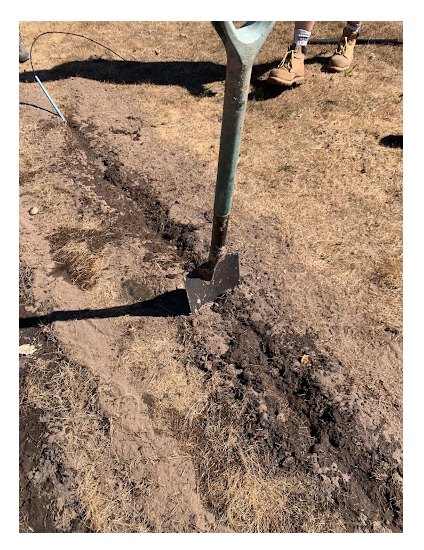
Ever heard of a fibre cable that can withstand a crush load up to 5000N!! Here is a story of how an enthusiastic group of engineers came up with a cable design that can actually withstand the highest of pressures, even that of a direct spade strike
The story dates back to 2021…
While trying to establish Gigabit networks in the UK, one of the largest service providers in the region realised the mounting pressure of meeting the 2025 deadline of full gigabit connectivity. Modelling to the Infrastructure Transition Research Consortium (ITRC) projects, the UK population will be 75 million by 2050. This 12.5% increase in population will further compound the need for faster connections with greater capacity.
Delivering fibre-optic cables to every community was a substantial challenge. However, one thing they knew was that if the technology chosen has been considered thoroughly, managing a fibre optic installation can be as simple as a cakewalk.
By selecting optical products that allow for an easy, error-free installation, service providers will be able to get jobs done more quickly and effectively.
An idea that entirely disrupted cable installation
Deploying FTTx typically involves digging a trench in the road or footpath to install ducting – all of which can be very disruptive. What’s more, in places where there are cobbled streets, for example, it can be costly and time and labour-intensive to take this approach.
Essentially service engineers wanted to limit the time spent on site, to reduce roadworks which ultimately cause congestion, disrupt productivity and increase public frustration.
They wanted a cable that is as strong as it can withstand any weather conditions (maximum breaking force ~2000 Newton), and still very flexible so that it could be bent for any type of deployment, be it aerial or underground. The high tensile strength of a fibre decides how much it is prone to breakage or can withstand a crushing load. It is generally measured in Newton (N).
Direct-buried cable was an answer to all this
To minimise installation times, the benefits of simple and efficient technology are clear-cut. Most underground cables require additional materials (i.e. duct and joints) to protect the cable underground and cover connections or break-out points, however, new-generation designs can go straight into the ground.
The idea clicked with STL’s Armored Reinforced Plastic (ARP) Drop Light Cables
ARP rods are non-metallic composites designed primarily for use as a central strength member in fibre optic cables. There are rugged, tightly buffered fibres reinforced with aramid yarns and sheathed with UV, chemical and abrasion-resistant polyurethane (TPU). The cable features a core made of Fibre Reinforced Plastic (FRP) that provided tensile strength and anti-buckling properties. Water swellable yarns were also added to prevent the entry of water at the core of the cable. ARP rods offer high tensile strength & better-bending properties with minimum weight.
In this design, these same ARP rods were installed in the outside of the cable jacket to provide a ruggedised ARP armored cable, with very high tensile strength for overhead installation, and very high impact and very high crush resistance for underground installation.
These cables are a testament to our spirit of innovation that makes it suitable to be used as:
Worksafe Aerial cable – As we innovate, we ensure safety is never compromised. The consequences of aerial cable breakage can be fatal. Poll infrastructure collapse caused by vehicle strikes can result in injury to personnel and can cause large-scale damage to equipment. Not to forget the costs involved in case of such disasters by way of compensation to be paid to personnel and for investing in new equipment. Our product designers have developed one of a kind predictive braking capability in the product with embedded strength members engineered such that it breaks below a particular force, thus ensuring human safety. The micro design of the cable enables ultra-compact fibre packing, hence reducing the overall cable diameter.
This enables easier handling and faster installation. This round cable can also be quickly and easily stripped, resulting in faster network rollouts.
Direct bury underground cables – ~28% of the service provider’s installations are underground and built currently using a duct. These cables are being designed keeping in mind their underground requirement.
Installing a cable underground usually involves 2 steps:
- Installation of duct
- Pulling up the cable.
Our cable converts this 2-step into a single step. Our cable allows direct bury installation without the need for duct installation and results in significant time and cost savings.
This underground drop cable has very high impact and crush strength and can withstand crush load till 5000 Newton!!!, which is due to the bulletproof aramid yarn used in the 3 x ARP (Aramid-Reinforced Plastic).
Yes, we actually did a spade test on the cable and found that the cable was still optically operational (with no fibre break) even after a direct spade strike, with signal loss well below the 1db limit, showing it is remarkably robust.

Direct burial cable tested for break resistance against spade attack
Also with the bend neutrality of the 3 x 120-degree embedded strength members, this cable excels in handling performance.
The beauty of this solution was way beyond its balance of strength and flexibility and ability to break smartly. In Australia, customers asked for rural connectivity solutions where they actually do end-to-end underground cable installations, directly buried without any ducts. When they used this cable, designed for aerial use, for a direct bury environment, the cable worked brilliantly.
Going forward, this cable design can be considered as universal for overhead, direct bury and duct installation.



